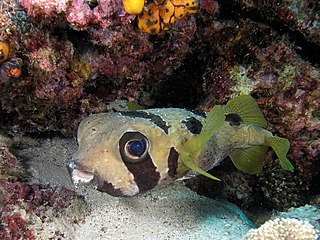
The black-blotched porcupinefish, also known as shortspine porcupinefish, is a member of the family Diodontidae. It is found in the tropical and subtropical waters of the Indo-Pacific on coral and rocky reefs and in inshore waters. Other names are the blotched porcupinefish and the brown-backed porcupinefish.

The spot-fin porcupinefish, also known as the spotted porcupinefish, black-spotted porcupinefish or simply porcupinefish, is a member of the family Diodontidae.
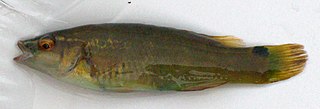
The goldsinny wrasse is a species of ray-finned fish, a wrasse from the family Labridae which is native to the eastern Atlantic Ocean and associated seas. This species is the only known member of its genus.
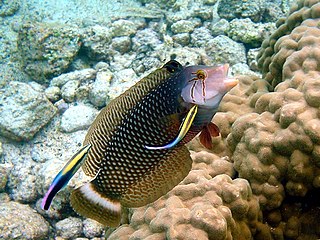
Novaculichthys taeniourus, also known as the rockmover wrasse, carpet wrasse, dragon wrasse, bar-cheeked wrasse, olive-scribbled wrasse or reindeer wrasse, is a species of wrasse mainly found in coral reefs and lagoons in the Indo-Pacific region. These include habitats in the Gulf of California to Panama; tropical Pacific Ocean islands including Hawaii; the Philippines, Indonesia and Australia; and the Indian Ocean to the east coast of Africa. The common name, "rockmover wrasse", comes from their behavior of upending small stones and reef fragments in search of prey. This species is the only known member of its genus.
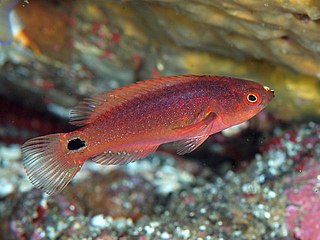
The exquisite wrasse is a species of ray-finned fish from the family Labridae, the wrasses, which is native to reefs in the Indo-West Pacific region. It can be found in the aquarium trade.
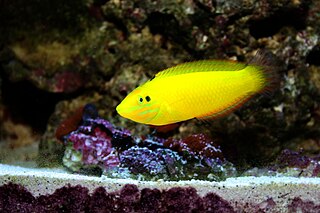
Halichoeres chrysus, commonly called the canary wrasse, golden wrasse or yellow wrasse, is a fish species in the wrasse family native to central Indo-Pacific area.
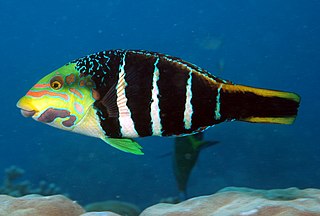
The barred thicklip wrasse is a species of fish belonging to the wrasse family, native from the Indo-Pacific.

The yellowhead wrasse is a fish species belonging to wrasse family native to shallow tropical waters in the Caribbean Sea and western Atlantic Ocean.
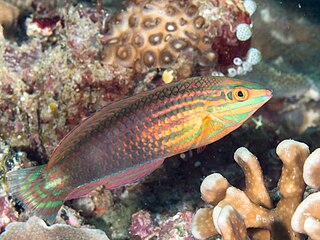
The red-lined wrasse, two-spotted wrasse or biocellated wrasse, Halichoeres biocellatus, is a species of wrasse native to shallow tropical waters in the western Pacific Ocean.

Halichoeres leucoxanthus, commonly called the Canarytop wrasse, Whitebelly wrasse, or Lemon meringue wrasse, is a fish species in the wrasse family endemic to the Indian Ocean.
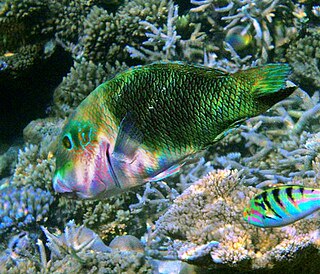
The blackeye thicklip wrasse or half-and-half wrasse is a species of fish belonging to the wrasse family. It is native to the Indo-Pacific.

Halichoeres prosopeion, commonly called the twotone wrasse, half-grey wrasse or zig-zag wrasse, is a fish species in the wrasse family native to the western Pacific Ocean.

Halichoeres richmondi, commonly called the Richmond's wrasse or chain-lined wrasse, is a fish species in the wrasse family native from the central Indo-Pacific.

Halichoeres scapularis, commonly called the Zigzag wrasse , is a fish species in the wrasse family native from the Indo-West Pacific.

The blackear wrasse is a species of wrasse, a type of fish in the family Labridae, from the warmer waters of the western Atlantic Ocean.

The lemon-striped pygmy hogfish is a species of ray-finned fish from the family Labridae, the wrasses. This species is found on reefs in the Coral Sea off the coast of Queensland and in French Polynesia.
Hologymnosus longipes, the sidespot longface wrasse or the plain slender wrasse, is a species of marine ray-finned fish from the family Labridae, the wrasses. It occurs in the western Pacific Ocean.

The bleeding wrasse is a species of marine ray-finned fish from the family Labridae, the wrasses. It is found in reefs in the eastern central Pacific Ocean.

Pseudocoris heteroptera, the torpedo wrasse or zebra wrasse, is a species of marine ray-finned fish, a wrasse from the family Labridae. It is found in the western Pacific Ocean where it is associated with reefs.
Symphodus caeruleus is a species of marine ray-finned fish, a wrasse from the family Labridae. It is endemic to the Azores in the eastern Atlantic Ocean.



















